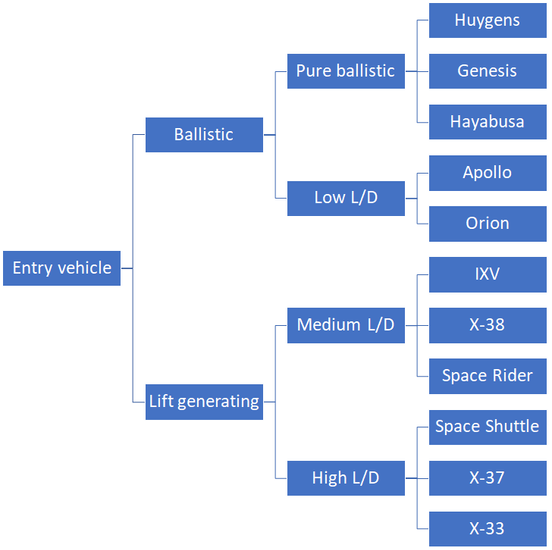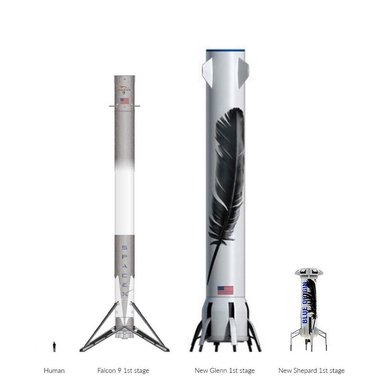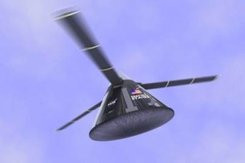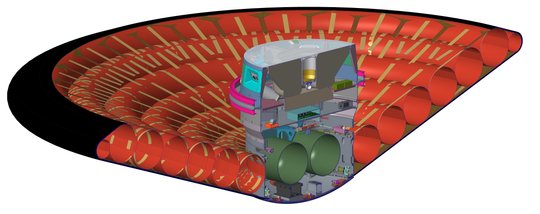V0.1 - 22-06-2020
Non-parachute Decelerators
Not all missions use a parachute. When one does not prefer a parachute landing, one can opt for a horizontal landing, propulsive landing, or autorotation. This page describes the three different landing methods that do not use a parachute system.
Horizontal landing
Some spacecraft, such as the X37, Buran, and Space Shuttle can land on a runway, much like an aircraft. When looking at entry vehicles, one can break them up into ballistic or lift generating bodies.
The ballistic capsules are the type of capsules most known from the crewed missions and some uncrewed spacecraft. Most crewed missions, such as Apollo and Orion, do have a non-zero lift over drag ratio (L/D). For the Apollo capsules, this was about 0.3, meaning that the capsule can manoeuvre during the atmospheric entry to decrease the peak deceleration, but cannot fully control its entry flight.
The lift generating capsules can be divided into medium and high L/D. The medium L/D missions still require some form of decelerator for a safe landing; examples include the X-38 and the Space Rider. The High L/D spacecraft are capable of performing safe landings on a runway without parachutes or other decelerators. The breakdown can be found in the figure below, together with the estimated L/D for several missions.
Mission | Subsonic L/D | Supersonic L/D | Catagory |
X-15 | 4 | 2 | High L/D |
Space Shuttle | 4 | 1 | High L/D |
Apollo | 0.4 | 0.36 | Low L/D |
IXV | 1.2 | 1.05 | Medium L/D |
HL-10 | 2.5 | - | High L/D |
Boeing 777 | 19.3 | - | Aircraft |
Comparison of various spacecraft showing the Lift over Drag ratio. The lift over drag ratio determines how far a spacecraft can glide through the atmosphere. In principle, one can say that the higher the L/D ratio is, the lower the peak deceleration during atmospheric re-entry.
Spacecrafts capable of landing on a runway have the advantage of performing a precision landing on the desired location. This means that the retrieval crew can access the payload relatively quickly. These vehicles, however, are usually much more complex compared to a ballistic entry vehicle. Besides being more complex to engineer, they can be more complex to engineer. Where Apollo could land basically anywhere in water, the Space shuttle had to stick the landing on the runway in one go. There are no clear optima for when to use any form of design. However, the inclusion of some lift, as with most crewed capsules, is favourable to reduce the mechanical and thermals loads during atmospheric entry. To compare, a typical Soyuz entry experience about 4g deceleration, where the Soyuz MS-10 experienced about 8g's during the ballistic entry.
Propulsive Landing
As an alternative to parachutes for the final deceleration, one can opt for a propulsive landing. Missions that opted for the propulsive landing over a parachute landing include the Falcon 9, New Shepperd, New Glenn, DC-X, and the lunar lander. Propulsive landing has the main advantage that an engine is already required to perform the ascend flight. It does mean that one needs the ability to control the throttle setting of the engine precisely.
As seen in the design of the Falcon 9, New Shepperd and New Glen launchers, one requires additional hardware in the rocket for a safe landing. These include, for instance, landing legs and some form of aerodynamic control. But one should also not forget the additional propellant and additional ADCS. The Falcon 9 opted for the now-famous grid fins, where Blue Origin went for more conventional fins for both their rockets. Besides the atmospheric control, both rockets have cold gas thrusters for attitude control when the atmosphere is too lean for aerodynamic control.
It is unclear why SpaceX or Blue Origin chose a propulsive landing over a parachute landing, that means there is no official statement from either company. However, when looking at the first flights of the Falcon 9, the landing was supposed to happen with a parachute system. During these early flights, the first stage never reached the point where the parachutes were to be deployed. It is thought this might be due to aerothermal heating during atmospheric entry, SpaceX solved this by performing an engine burn just before the first stage hit the atmosphere. This decreased the velocity, and thus the dynamic pressure. It is thought that, because SpaceX already performed an engine burn during the descent they decided to stick with a propulsive landing. This theory is supported by the announcement of Rocketlab to retrieve the Electron first stage using a Ballute and Parafoil combination.
The Ballute is a type of parachute that is capable of operating at very high Mach numbers and thus decreasing the terminal velocity of the Electron first stage early on in the flight. By using this ballute Rocketlab mitigates the re-entry issues experienced by SpaceX.
Comparison of the Falcon 9, New Shepperd, and New Glenn rockets. One can see the aerodynamic control surfaces.
Helicopter landing
A more exotic method of capsule recovery can be found in the autorotation landings. Autorotation is when a helicopter moves through the air without engine power. This means that the air pushes the rotor into motion, creating lift, decreasing the helicopter's vertical velocity. The same concept can be performed on a rocket or spacecraft.
The most notable example is the Rotary Rocket. This concept uses a rotor on top of the capsule to generate lift. The rotor was equipped with tip rockets, bringing the main rotor into motion. Therefore, it was not a pure autorotation solution. Having a rotor instead of a parachute allows for more control of the landing location, thus allowing for a precision landing. Furthermore, the rotor setting could allow for control over the trajectory, much like a lift generating body.
Early research from NASA has shown autorotation concepts for the Apollo and even the Orion capsules. Several wind tunnel tests and simulation studies have been performed, leading to the conclusion that, even though it is a system with many advantages, technology is not ready for the system to work.
The system has problems with the mechanical and thermal loads on the rotor blades. At the moment, no functional solutions have been found for these problems. Solutions are being investigated in the form of coatings and flight profiles.
Render of an Apollo-like capsule with a helicopter rotor system.
Inflatable decelerator
Although parachutes produce significant amounts of drag and can be used during both supersonic and subsonic phases, there are phases where parachutes cannot be used as thermal or mechanical stresses are too high. These phases are usually around the re-entry point. An additional issue is the lack of atmosphere to inflate a parachute. To still be able to control the deceleration during these phases a Hyper- or Supersonic Inflatable Aerodynamic Decelerator (HIAD/SIAD) can be used. These, as the name suggests, are decelerators that are inflated, usually before re-entry and could serve both as decelerator and heat shield. They artificially create a larger surface area to be used for creating drag. It is inflated using a build-in inflation system so it can be deployed even in vacuum conditions.
Scematic of the LOFTID mission
This means it is ideal for decelerating in low-density environments such as on Mars. A HIAD can come in several forms. The most common is a conical HIAD created out of stacked toroids at a relatively obtuse angle (half-angle between 45-70 deg). The fact that it can be deployed before re-entry means it decreases the maximum load of both the deceleration and the temperature during re-entry. Currently, HIADs are being investigated for use on the new Vulcan system to land and re-use the first stage engine section and future mars missions.





